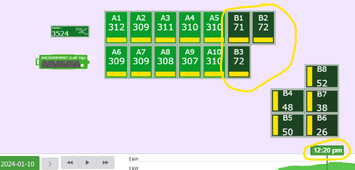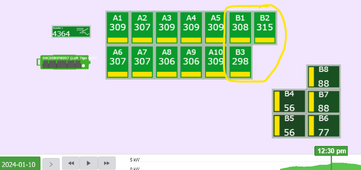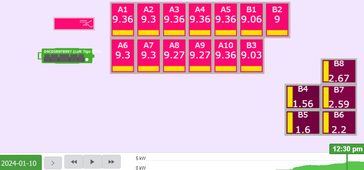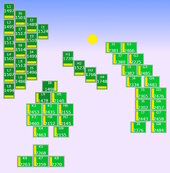EastCoastDIYer
New Member
My Tigo TS4-O optimisers on one of my strings is not behaving as I would expect and would like a second opinion on what Tigo support have left me with please.
On clear sunny days, my panels are massively underperforming and I can't find a good reason why. Tigo support have humoured me with many responses to a ticket I raised with them, but ultimately what they have said back to me doesn't add up, or I'm left feeling like I'm missing key part of the equation that explains this.
I had my solar installed last year 18/12/23 and live in the UK. My house is an L shape with a ridged roof on all of it, and I have a two string Solis Hybrid Inverter with String A with 10 south facing Jinko Tiger Neo 435w Mono panels, and on String B I have 3 panels on the south facing roof and 5 on the west facing roof. All panels are the same and have Tigo TS4-O monitored optimisers on all of them, connected to a CCA. Tigo tells me that they are all on the latest firmware. The Jinko Tigers produce approx 35 volts from very low light.
The optimisers on String A are behaving as expected. At the moment in the winter, there's a tree which casts a scattered shadow across the lower panels, and I can see the optimisers are doing their job to allow the unshaded panels to keep producing an expected amount of power. For the optimisers to start working, it seems that as soon as there's more than 0.5 amps being recorded by all the Tigos, the string comes alive as I presume the optimisers are starting to do their jobs and bypassing tunnelling any shaded panels. 0.5 amps for each panel happens fairly early on in relation to when the sun comes up.
String B is where I have the problem. It is split across the south facing roof with 3 panels B1, B2 & B3 (alongside the String A panels) and 5 panels on the west facing roof B4, B5, B6, B7 & B8. The 3 south facing panels only start producing meaningful power after 12:00. All 3 are all unshaded by about 11:00, so it's not shade related. Taking B1 as an example, it's neighbour A5 at 11:20 is producing 303 watts from 35v x 8.66amps. B1 is producing 30 watts from 39v x 0.77amps. Every other of the 8 string B panels is producing at least 0.71amps at 34v or higher. B1 continues to underperform compared to A5 until about 12:00 when over the next 30 minutes it's amps ramps up until it's matching A5. At 12:00 there's still one panel, B5, with 0.78 amps due to some shading and being west facing, but the rest of the west facing have more.
Tigo support have told me that the TS4-O needs a minimum of 16v and 0.5amps for them to start optimising, and what I see on String A agrees with this, but string B doesn't as they're making more than those numbers but not optimising/ bypass tunnelling.
Tigo support also told me "In your case, the shading occupies more than 60% of the string, and B1/2/3 have to match the performance of the whole string to make it more efficient." The shading they are referring to is because the 5 West facing panels are facing away from the sun before approx. 12:00. I don't understand the part about "B1/2/3 have to match the performance of the whole string to make it more efficient" but that could be ignorance on my part. But what I do know is that these optimisers are often marketed as being a solution to having panels across more than 1 orientation on the same string. Certainly my installer thought that was the case. But now Tigo are saying that if more than 60% of panels are shaded, even if they have enough amps to enable the optimisers, then those in the sun can't work at their full potential. So can you only have them across more than one orientation if it's effectively a 50:50 split of panels?
Does this sound right, am I missing something or are they giving me the brush-off please?
Here's the wattage per optimiser on 16/01/24 @ 12:15
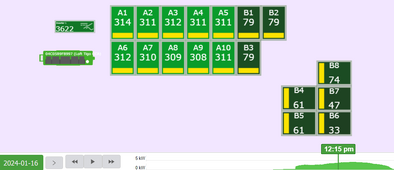
And current
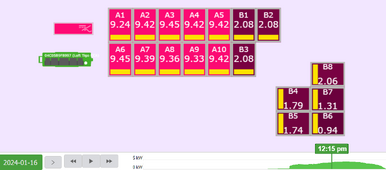
Thank you, good people!
On clear sunny days, my panels are massively underperforming and I can't find a good reason why. Tigo support have humoured me with many responses to a ticket I raised with them, but ultimately what they have said back to me doesn't add up, or I'm left feeling like I'm missing key part of the equation that explains this.
I had my solar installed last year 18/12/23 and live in the UK. My house is an L shape with a ridged roof on all of it, and I have a two string Solis Hybrid Inverter with String A with 10 south facing Jinko Tiger Neo 435w Mono panels, and on String B I have 3 panels on the south facing roof and 5 on the west facing roof. All panels are the same and have Tigo TS4-O monitored optimisers on all of them, connected to a CCA. Tigo tells me that they are all on the latest firmware. The Jinko Tigers produce approx 35 volts from very low light.
The optimisers on String A are behaving as expected. At the moment in the winter, there's a tree which casts a scattered shadow across the lower panels, and I can see the optimisers are doing their job to allow the unshaded panels to keep producing an expected amount of power. For the optimisers to start working, it seems that as soon as there's more than 0.5 amps being recorded by all the Tigos, the string comes alive as I presume the optimisers are starting to do their jobs and bypassing tunnelling any shaded panels. 0.5 amps for each panel happens fairly early on in relation to when the sun comes up.
String B is where I have the problem. It is split across the south facing roof with 3 panels B1, B2 & B3 (alongside the String A panels) and 5 panels on the west facing roof B4, B5, B6, B7 & B8. The 3 south facing panels only start producing meaningful power after 12:00. All 3 are all unshaded by about 11:00, so it's not shade related. Taking B1 as an example, it's neighbour A5 at 11:20 is producing 303 watts from 35v x 8.66amps. B1 is producing 30 watts from 39v x 0.77amps. Every other of the 8 string B panels is producing at least 0.71amps at 34v or higher. B1 continues to underperform compared to A5 until about 12:00 when over the next 30 minutes it's amps ramps up until it's matching A5. At 12:00 there's still one panel, B5, with 0.78 amps due to some shading and being west facing, but the rest of the west facing have more.
Tigo support have told me that the TS4-O needs a minimum of 16v and 0.5amps for them to start optimising, and what I see on String A agrees with this, but string B doesn't as they're making more than those numbers but not optimising/ bypass tunnelling.
Tigo support also told me "In your case, the shading occupies more than 60% of the string, and B1/2/3 have to match the performance of the whole string to make it more efficient." The shading they are referring to is because the 5 West facing panels are facing away from the sun before approx. 12:00. I don't understand the part about "B1/2/3 have to match the performance of the whole string to make it more efficient" but that could be ignorance on my part. But what I do know is that these optimisers are often marketed as being a solution to having panels across more than 1 orientation on the same string. Certainly my installer thought that was the case. But now Tigo are saying that if more than 60% of panels are shaded, even if they have enough amps to enable the optimisers, then those in the sun can't work at their full potential. So can you only have them across more than one orientation if it's effectively a 50:50 split of panels?
Does this sound right, am I missing something or are they giving me the brush-off please?
Here's the wattage per optimiser on 16/01/24 @ 12:15

And current

Thank you, good people!



